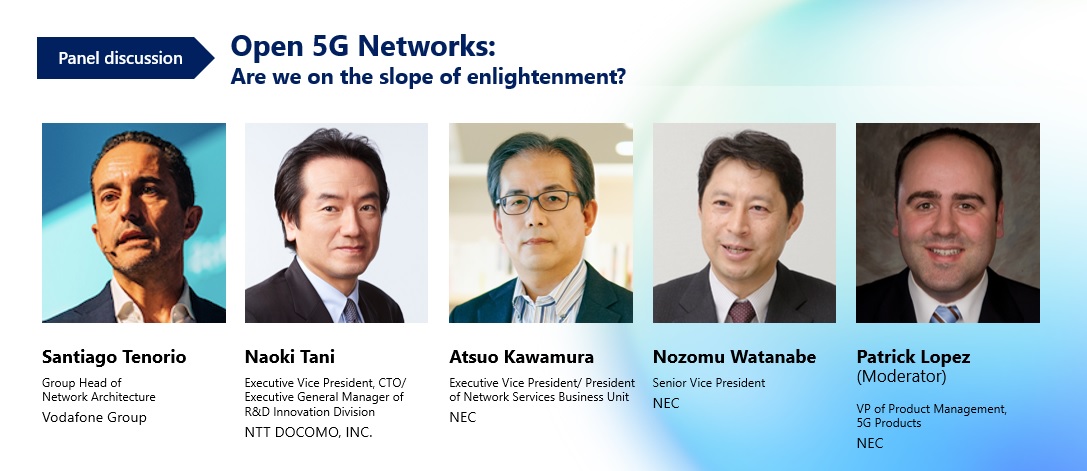Mexico
Breadcrumb navigation
January 12, 2022


Open 5G Networks:
An In-Depth Look into the Priorities of the Tier 1s Leading the Charge to Mass Deployment


Open 5G Networks
An In-Depth Look into the Priorities of the Tier 1s Leading the Charge to Mass Deployment
Over the past decades, the telecom industry has been adapting and evolving their networks with openness, and RANs are the last piece of the puzzle needed to unlock the full potential and flexibility desired of networks in the 5G era. This metamorphosis is enabled by Open RAN. But is the hype real? Can it guarantee the same features and performance as traditional networks? Are the benefits worth the expected challenges?
If anyone has the answer, it’s the leading experts from the communication giants. And if their recent efforts are any indication, then the answer to all the above questions is a resounding yes.
Let’s take a closer look at a recent discussion held by NEC featuring guest speakers from NTT DOCOMO and Vodafone (of which NEC has engaged with as partners on the Open RAN front) to really understand the scale of the ongoing efforts to bring 5G to every person, device, and business in the world, and what true openness brings to the table.
Large-Scale Deployment, Enabled by Openness
The benefits of an Open RAN network are as bountiful as they are easy to understand. The option to pick and choose optimal components leads to the building of optimal networks, and today’s telecom giants are going all in. For instance, since launching 5G commercial services in March 2020, NTT DOCOMO has now deployed over 10,000 O-RAN compliant 5G base stations and they have more than 5 million subscribers, both metrics which they expect to double by March 2022. These systems also utilize a pure 5G core in standalone mode provided by NEC.
Due to NTT DOCOMO’s early work on open network interoperability, as of 2020, the company has products from 15 vendors which can be interconnected. To further progress in this area, NTT DOCOMO has started a 5G Open RAN Ecosystem, which currently has 13 members, including NEC.
Looking at these figures, it should come as no surprise that NTT DOCOMO is a strong believer in the Open RAN movement.
“The reason behind why 5G is drawing so much attention is because 5G can provide newly added values and solutions to social issues…in order to achieve this, 5G needs to flexibly and swiftly meet various demands from various industries. An open network combining the assets of various vendors and solutions is critical for this purpose,” commented Tani.
Like NTT DOCOMO, Vodafone has a long history with Open RAN, with initial R&D efforts starting in 2013 which have continued to the present day. The four largest mobile operating groups in Europe have joined forces to create unified Open RAN specifications, and Tenorio mentioned that ”Open RAN is no longer a matter of if, but rather a matter of when (it will happen).” In June Vodafone UK announced that it will be the first commercial deployment of Open RAN in Europe, which counts NEC as one of its key partners.
To Tenorio, the popularity of Open RAN can be summed up as a simple matter of supply and demand. “I think that the driver hasn’t particularly been 5G, but the lack of optionality for operators to choose among when you are picking a vendor to deploy a radio. It’s not a secret when you look at the number of major incumbents, consolidation has reduced that number to basically three in some regions…in my opinion that has made Open RAN particularly trending at this precise time.”The Future: A Slice of Open RAN Pie for Everyone
The very nature of Open RAN means that not only the telco giants, but even small to mid-sized telcos will have the opportunity to deploy Open RAN networks. Tenorio believes that the first step is for a system integrator-friendly business model to be developed. This means that right now it really comes down to the major players to test setups, find the best paths forward, and then pave those paths for the ones who follow.
Of course, a large part of the setup process involves selecting an Open RAN vendor. As a benchmark in terms of what telcos should be on the lookout for in a vendor, Watanabe from NEC highlighted three factors that NEC possesses: 1) experience in commercializing Open RAN, 2) experience in both IT and telecom to make the most of the architecture, and 3) experience as system integrator.
The NEC Approach to Open RAN
2021 thus far has been a breakout year for NEC in terms of Open RAN progress, as the company has added many new customers to its open network footprint. For example, NEC announced that it will be a key supplier to Deutsche Telekom’s O-RAN Town pilot project, and also announced that it would be participating in Telefónica’s trials in its key markets of Spain, the UK, Germany and Brazil. Collaboration with long-standing Open RAN operators such as NTT DOCOMO, Vodafone, and Rakuten also deepened over the course of the year.
Tenorio commented, “We are very excited to have NEC as an Open RAN partner, as we saw after heavy and harsh scrutiny of everything that is available out there we thought that NEC Massive MIMO was the best choice for us….after that I have seen other operators making the same choice.”

 zoom
zoom